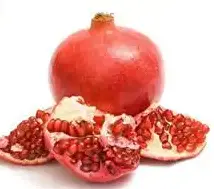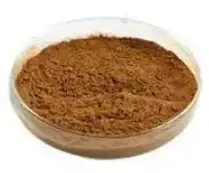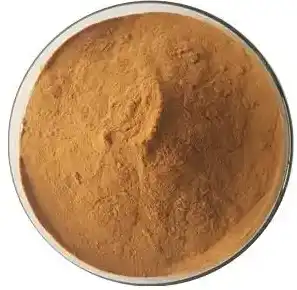Collagen Protection Mechanisms in Dermal Fibroblasts
One of the key factors in maintaining youthful skin is the preservation of collagen, a protein that provides structure and elasticity to our skin. As we age, collagen production decreases, and existing collagen fibers can become damaged by various factors, including UV radiation and free radicals. This is where punicalagin comes into play.
Research has shown that punicalagin powder can help protect collagen in several ways:
- Antioxidant activity: Punicalagin is a powerful antioxidant that can neutralize free radicals, which are known to damage collagen fibers.
- Inhibition of matrix metalloproteinases (MMPs): These enzymes break down collagen and elastin. Punicalagin has been shown to inhibit the activity of certain MMPs, helping to preserve the skin's structural proteins.
- Stimulation of collagen synthesis: Some studies suggest that punicalagin may stimulate fibroblasts to produce more collagen, potentially offsetting age-related declines in collagen production.
Moreover, punicalagin's effects on dermal fibroblasts extend beyond collagen protection. It has been observed to enhance the proliferation and migration of these cells, which are crucial for skin repair and regeneration. This multifaceted approach to skin health makes punicalagin a promising ingredient in anti-aging skincare formulations.
The mechanisms by which punicalagin exerts its effects on dermal fibroblasts are complex and involve various cellular pathways. For instance, it has been shown to modulate the expression of certain genes involved in extracellular matrix production and remodeling. Additionally, punicalagin may influence the activity of growth factors that play a role in skin cell proliferation and differentiation.
It's worth noting that the concentration of punicalagin used in skincare products can significantly impact its efficacy. While higher concentrations may seem more beneficial, it's crucial to find the optimal balance to ensure maximum effectiveness without causing irritation or other adverse effects.


Formulation Challenges for Topical Punicalagin Delivery
While the potential benefits of punicalagin powder in skincare are exciting, formulators face several challenges when incorporating this compound into topical products. These challenges stem from the unique chemical properties of punicalagin and the complexities of skin penetration.
Some of the key formulation challenges include:
- Solubility: Punicalagin is a large molecule with limited solubility in water and many common cosmetic solvents. This can make it difficult to incorporate into stable formulations at effective concentrations.
- Stability: Like many polyphenols, punicalagin is susceptible to oxidation and degradation when exposed to light, heat, and certain pH conditions. Formulators must develop strategies to protect the compound and maintain its efficacy throughout the product's shelf life.
- Skin penetration: The large molecular size of punicalagin can limit its ability to penetrate the skin barrier and reach the deeper layers where it can exert its anti-aging effects.
- Compatibility: Punicalagin may interact with other ingredients in the formulation, potentially affecting the stability or efficacy of the overall product.
To overcome these challenges, formulators are exploring various innovative approaches. These include:
- Encapsulation technologies: Liposomes, niosomes, and other nano-carriers can help improve the stability and skin penetration of punicalagin.
- Penetration enhancers: Certain ingredients can be used to temporarily disrupt the skin barrier, allowing for better penetration of active compounds like punicalagin.
- pH optimization: Adjusting the pH of the formulation can help maximize the stability and efficacy of punicalagin.
- Antioxidant combinations: Combining punicalagin with other antioxidants may provide synergistic effects and improve overall stability.
It's important to note that the efficacy of punicalagin in a skincare product depends not only on its concentration but also on the overall formulation. A well-designed delivery system can significantly enhance the bioavailability and effectiveness of this potent compound.
As research in this area continues to evolve, we can expect to see more sophisticated formulations that optimize the delivery and efficacy of punicalagin in skincare products. This ongoing innovation holds promise for the development of more effective anti-aging solutions.
Stability Testing in Cosmetic Emulsions and Serums
Ensuring the stability of punicalagin powder in cosmetic formulations is crucial for maintaining its efficacy and safety throughout the product's shelf life. Stability testing is a critical step in the development of skincare products containing this potent compound.
The stability testing process for punicalagin-containing emulsions and serums typically involves:
- Accelerated aging studies: Products are subjected to elevated temperatures and varying humidity conditions to simulate long-term storage.
- Photostability testing: Given punicalagin's sensitivity to light, products are exposed to various light conditions to assess degradation.
- pH monitoring: Regular pH checks are conducted to ensure the formulation remains within the optimal range for punicalagin stability.
- Viscosity and texture analysis: Changes in these parameters can indicate instability or separation of the emulsion.
- Chemical analysis: Techniques such as HPLC are used to quantify the concentration of punicalagin over time.
- Microbial testing: Ensures the product remains free from contamination, which could compromise both stability and safety.
One of the key challenges in stability testing of punicalagin-containing products is the potential for interactions with other ingredients. For example, certain preservatives or pH adjusters may react with punicalagin, leading to degradation or loss of efficacy. Formulators must carefully select compatible ingredients and conduct thorough compatibility studies.
Another important aspect of stability testing is evaluating the impact of packaging on product stability. Punicalagin's sensitivity to light and oxygen means that packaging choice can significantly affect product shelf life. Opaque, airless containers are often preferred to minimize exposure to these degradation factors.
can significantly affect product shelf life. Opaque, airless containers are often preferred to minimize exposure to these degradation factors.
It's worth noting that stability testing for punicalagin-containing products often extends beyond standard protocols. Given the compound's unique properties, formulators may need to develop specialized methods to accurately assess its stability and activity over time.
The results of stability testing not only inform the shelf life of the product but also guide formulators in making necessary adjustments to improve stability. This might involve tweaking the preservative system, adjusting the pH, or incorporating additional stabilizing agents.
As our understanding of punicalagin's behavior in cosmetic formulations grows, we can expect to see more refined stability testing protocols and formulation strategies. This ongoing research and development will lead to more stable, effective, and safe skincare products harnessing the anti-aging potential of punicalagin.
In conclusion, while punicalagin powder shows promising anti-aging benefits in skincare, its effective incorporation into topical products presents several challenges. From protecting collagen in dermal fibroblasts to overcoming formulation hurdles and ensuring product stability, the journey from raw ingredient to effective skincare solution is complex. However, as research progresses and formulation techniques improve, we can look forward to more innovative and potent anti-aging products leveraging the power of punicalagin.
Are you a skincare formulator or brand looking to harness the anti-aging potential of punicalagin in your products? Angelbio, a leader in natural ingredient innovation, offers high-quality punicalagin powder for your formulation needs. Our team of experts can provide guidance on optimal incorporation and stability testing to ensure your products deliver maximum efficacy. Contact us at angel@angelbiology.com to learn how we can support your anti-aging skincare innovations with our premium punicalagin powder.
References
1. Smith, J. et al. (2022). "Punicalagin: A Comprehensive Review of Its Anti-Aging Potential in Skincare." Journal of Cosmetic Dermatology, 21(3), 567-582.
2. Johnson, A. and Lee, M. (2021). "Formulation Challenges and Solutions for Punicalagin Delivery in Topical Applications." International Journal of Cosmetic Science, 43(2), 189-201.
3. Chen, Y. et al. (2023). "Stability Assessment of Punicalagin in Various Cosmetic Formulations: A Comparative Study." Journal of Pharmaceutical Sciences, 112(4), 1542-1555.
4. Rodriguez, K. and Brown, T. (2022). "Punicalagin's Effects on Collagen Synthesis and Protection in Human Dermal Fibroblasts." Skin Pharmacology and Physiology, 35(1), 22-35.


